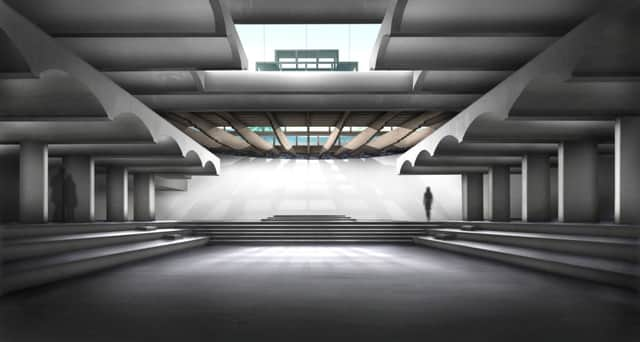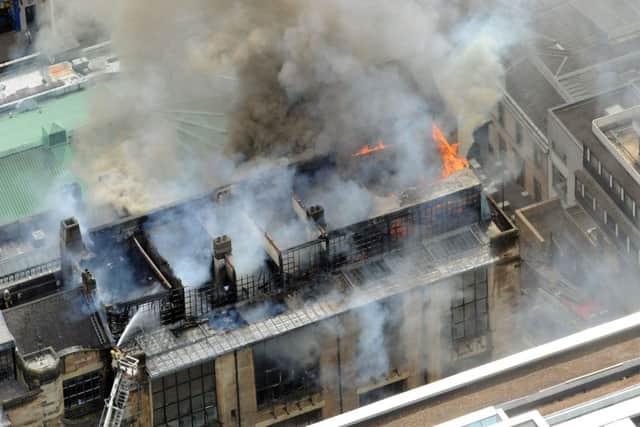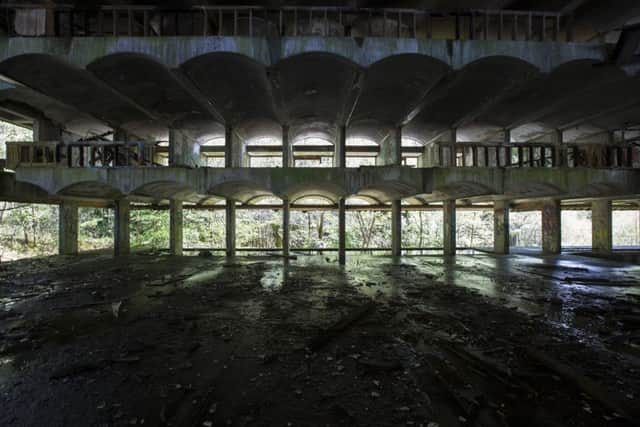Architecture in focus as Scotland gears up for year of grand designs


WHEN fire tore through Glasgow School of Art’s Mackintosh building on 23 May, 2014, the shockwaves spread far beyond the confines of the creative community. A jewel in the architectural crown of Scotland’s largest city – a city whose share of the finest buildings in the United Kingdom might appear to the envious outsider to be unfairly generous – the Mackintosh building is cherished by many Glaswegians; the damage to the building was a source of considerable anguish. As firefighters battled the flames, students and passers-by stopped to look on. This didn’t appear to be the usual rubber-necking: many of those present were in tears.
Much contemporary art can seem distant or elitist (or may too often be caricatured as such) but the reaction to the fire in 2014 revealed a deep bond between the Art School and people from all walks of life in Glasgow and beyond.
Advertisement
Hide AdAdvertisement
Hide AdScotland, of course, has a rich history of architectural brilliance. Along with the designer of the Glasgow School of Art, Charles Rennie Mackintosh, such innovators as Robert Adam, William Adam, William Henry Playfair, Alexander “Greek” Thomson and Patrick Geddes have left their marks on our urban landscape. For a further example of remarkable innovation, consider the masterpiece that is Edinburgh’s New Town, which first took shape after a competition to find a modern layout was held in 1766. The winner, 26-year-old James Craig, came up with an original design which, 200 years later, would contribute to the capital city’s New Town and Old Town being designated a Unesco World Heritage Site.


Contemporary structures add a new layer to our built environment, taking inspiration from and sometimes reacting against past achievements in design. The Falkirk Wheel, for example, is the only rotating boat wheel of it kind in the world, opened in 2002 to reconnect the Forth and Clyde Canal and the Union Canal for the first time since the 1930s.
And in two years’ time, the doors are scheduled to open at the V&A Museum of Design in Dundee, billed as an international centre of design for Scotland and the first ever design museum to be built in the UK outside London. Last year, Dundee was officially recognised by the United Nations as a Unesco City of Design – the first in the UK to be awarded the honour.
The relationship between people and buildings, running so much deeper than matters of practicality, is at the heart of a programme of events next year that will form Scotland’s Festival of Architecture.
Curated by the Royal Incorporation of Architects in Scotland (RIAS) and described by organisers as “the most ambitious ever nationwide celebration of the built environment of a single country”, the Festival Architecture has prompted the national tourism agency, VisitScotland, to invest in a number of related events and to declare 2016 Scotland’s Year of Innovation, Architecture and Design.


Throughout the year, that will mean events celebrating all manner of innovations, from Harris Tweed to best-selling computer games. But the real meat is to be found in the ambitious programme put together by RIAS. Innovation and Design play second fiddle to architecture next year. There will be more than 400 events and exhibitions throughout the length and breadth of Scotland.
VisitScotland’s involvement signals the belief that there’s a tourism buck to be made out of selling Scotland’s architecture – both historic and new – as an attraction.
The guardian of Scotland’s architectural past – the National Trust for Scotland – might retain an air of traditionalism, but organisers of next year’s events have an eye on the future. Teenage musicians will be invited to enter a competition to have their composition, inspired by contemporary architecture, performed by the Royal Scottish National Orchestra, and visitors can expect pop up pavilions in the heart of Edinburgh, the recreation of locations from sci-fi movies in Glasgow, and the construction of a model of the national museum, made entirely from Lego bricks.
Advertisement
Hide AdAdvertisement
Hide AdThe branding of 2016 as the Year of Innovation, Architecture and Design, follows this 2015’s Year of Food and Drink status, and 2014’s Year of Homecoming. Prior to that, there have been the year of Natural Scotland (2013), the year of Creative Scotland (2012) and the Year of Active Scotland (2011). Preparations are already under way for 2017 and 2018, which will be the Year of History, Heritage and Archaeology, and the Year of Young People, respectively.
These celebrations are intended to boost tourism and the level of investment shows a willingness to gamble on making a return. A programme of 28 official events to mark the Year of Innovation, Architecture and Design will receive £265,350, while the Festival Architecture will have funding at the equivalent of £1,000 per event, comprising of £300,000 from the Scottish Government and £100,000 from VisitScotland.
But government sources concede that it’s difficult to break down whether “Year of…” events make a difference to tourism. As one civil servant put it: “We can’t say what the tourism take would have been in 2014 if it hadn’t been the Year of Homecoming because it was the Year of Homecoming.
“But it’s better to pitch something than to sit back and take tourists for granted.”
St Peter’s Seminary in Cardross stands in stark contrast to its surroundings. The brutalist block might appear more congruous in a city than in a small village in Argyll and Bute. Organisers will launch the Festival of Architecture with a nighttime event at the seminary, making the most of the dramatic juxtaposition of rural and modernist.
That event alone will cost more than £100,000, though with plans in train to open the seminary as a platform for international arts in 2018, VisitScotland is speculating on accumulating business. Turning the festival – and the entire Year of Innovation, Architecture and Design – into a financial success is the responsibility, ultimately, of the quango. VisitScotland chairman, Mike Cantlay, is enthusiastically on-message about the potential for generating new interest in Scotland as a tourist destination.
He said: “With this new themed year we have the opportunity to put Scotland on the map in a new and exciting way, catching the attention of visitors old and new, positioning Scotland as a mix of traditional and cutting-edge at the same time.
“Scotland is a nation of pioneers, home to ground-breaking scientists, philosophers, engineers and architects for hundreds of years. From the Forth Rail Bridge to Dolly the Sheep, the telephone to the television, Charles Rennie Mackintosh to Andy Scott, and Harris Tweed to the iconic Mackintosh raincoat, Scotland’s innovative past, present and future continue to inspire and influence audiences across the globe, shaping the modern world we live in today.
Advertisement
Hide AdAdvertisement
Hide Ad“The events planned for the Year of Innovation, Architecture and Design 2016 are diverse, interesting and inspiring and we look forward to what we hope will be a ground-breaking year for tourism.”
Councillor Archie Graham, chair of Glasgow Life, which manages the Charles Rennie Mackintosh designed Scotland Street School Museum in Glasgow, added: “We hope to welcome many new visitors during the Year of Innovation, Architecture and Design.”
But for others the next year is less about the bottom dollar and more about having a positive impact at home, in engaging more people with architecture and design.
Stewart Murdoch, chair of Unesco City of Design Dundee and Dundee’s Director of Leisure and Culture, said: “Scotland’s Year of Innovation, Architecture and Design will be a thrilling celebration of our nation’s great creative strengths, and the programme of new activities commissioned especially for the year will help reach new audiences and communities throughout Scotland.
“In Dundee, we’re delighted that projects including Abertay University’s Dare ProtoPlay computer games festival and the Ignite Dundee festival have received support to deliver bigger, better events that will reach more people, inspiring them to unleash their own creative potential.”
And David Dunbar, chair of the Festival of Architecture said: “This national celebration of great architecture will transform Scotland’s relationship with its built environment. It will improve our appreciation and understanding. It will also be great fun.”
Culture Secretary Fiona Hyslop said: “The exciting programme for the Year of Innovation, Architecture and Design announced today will showcase Scotland’s greatest contemporary assets, innovative icons and hidden architectural gems, inspiring visitors and people from all over Scotland to get involved.
“From Styling the Nation through to the Festival of Architecture, these events – which take place in every corner of this country – will demonstrate our track record of excellence in innovation and design.”
Advertisement
Hide AdAdvertisement
Hide AdIn the aftermath of the fire at the Mackintosh building, the writer and broadcaster Muriel Gray – in her capacity as chair of the Glasgow School of Art’s board of governors – appeared on TV news bulletins, fighting back tears. Gray, a graduate of the school, was clearly distraught about what was then thought to be irreparable damage.
Now, with plans to reconstruct the Mac moving ahead, Gray is able to identify some positives which sprung from the disaster.
She said: “Two encouraging things tugged personally at my heartstrings in Glasgow, recently. The first was the incredible public support for the refurbishment of Kelvingrove [Museum and Art Gallery] and the second was the effect the fire damage to Mackintosh’s masterpiece had on people you wouldn’t have expected to cherish it.
“It reminded us that architecture and the built environment enter people’s lives by osmosis and that it really matters.”
Gray added: “We can see the same thing happening in Scottish rural architecture where an educated modernity and functionality, from some fantastic small practices, has begun to save the landscape from the previous vandalism of the ubiquitous, non-site-specific ranch-style bungalow .
|Architects have always been bold and creative. What’s changing now is that the client, we the public, have started to become that too.
“It’s a very exciting time. It’s like we’ve woken up.”